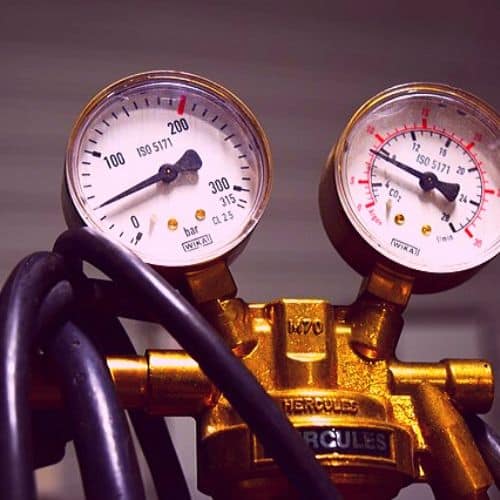
If you have welded before, you should know that the gas regulator or flow meter is necessary to be able to use the right amount of gas whenever you are welding. Not only that but it is also important to have one for keeping the high pressure of the gas cylinder under control. Using an inadequate regulator is also very dangerous! For that reason, I would also like to note that depending on how often you weld, you should change your flow meter or regulator form time to time (about every 5 years).
Types of regulators
Contents
There are different gas regulators and flow meters for every type of gas you might use. It is very important to use the right kind of regulator, especially if you are using highly flammable gases like propane and acetylene which are the most unstable gases that one can use.
Argon and Argon/co2 Regulators
Argon and Argon/Co2 regulators for MIG welding have two gauges. One that is showing you the pressure of your gas cylinder (usually on the left) and on the right the gauge should show you the delivery of gas flow rate. It is usually in cubic feet per hour, some are also in the metric system, indicating liters per minute.
Here is the flow meter I would recommend from Amazon.
I wrote a whole post about correct flow rates as well. You can read it here.
Regulators for TIG welding
If you have a multi-process welder and you are using argon, then you can use it for TIG welding as well without any problems. Now If you want to use helium, although the regulators for helium are technically the same as for argon, do not use argon regulator for helium! It is even more important when you previously have already used the regulator with argon.
Co2 Regulator for Welding
Generally, the Carbon Dioxide regulator is the same as Argon/Co2 regulators. The main difference besides the looks is the fitting of the regulator. Instead of being with male thread as it is argon regulators, for Co2 it is female. That is because the Carbon Dioxide cylinders have a female fitting.
If you need one, check this one out: https://amzn.to/322hn99
Should you consider using a flow meter instead of a gas regulator?
I think it is more of a preference which one to use. You can do everything you need with a simple regulator that usually comes with a welder, but some debate that the flow meter is more accurate because the indicator gauge can lie but the flowing ball will not. If the gas is there, the ball will flow, simple as that.
How does a welding gas regulator work?
Before we go any further, I can not stress this enough, for each gas type you have a different regulator. The regulators for different gases have different built, which more than likely will lead to failure if not used properly. The most obvious difference would be the threads of the fittings. For combustible gases like propane and acetylene, the opposite thread (left hand) is used for extra safety.
Theoretically, the construction of the regulator is simple actually. Gas comes in from one side entering a high-pressure chamber, which is separated by the first valve from the second, low-pressure chamber. The valve itself is controlled by the knob on your regulator. From there you determine how much gas you want to let out to the second chamber. Due to that, if the amount of pressure on the second chamber reaches your selected parameters, the pressure created in the second, bigger chamber helps to close the first valve.
How to install the regulator?
First of all, the most important thing is to inspect your gas regulator or flow meter of any damages and defects and make sure that the valves and connections are clean from any debris. If that’s done, you can go on and screw it directly to your gas cylinder. You should not need to apply much force, but if you do, you might have a wrong regulator.
Screw it by hand as much as you can and then tighten it with a wrench
After installing, you can open the cylinder and check if there are any leaks with a soap solution. If you see any bubbles, you can try to tighten the connections a bit more with a wrench, it should fix the problem.
Conclusion
As I already said, dealing with high pressured cylinders is dangerous so it is important to use the correct regulator for welding as well as for oxy/acetylene welding and cutting.
As an extra tip, I would recommend you to close the gas cylinder valve after you are done welding because of the potential leaks. It has happened to me multiple times – coming to the workshop and discover that the shielding gas bottle is empty
I hope this article was helpful to you, picking the right type of regulator for your welding machine!
If you would like to know how much shielding gas costs for MIG welding, read this as well.
